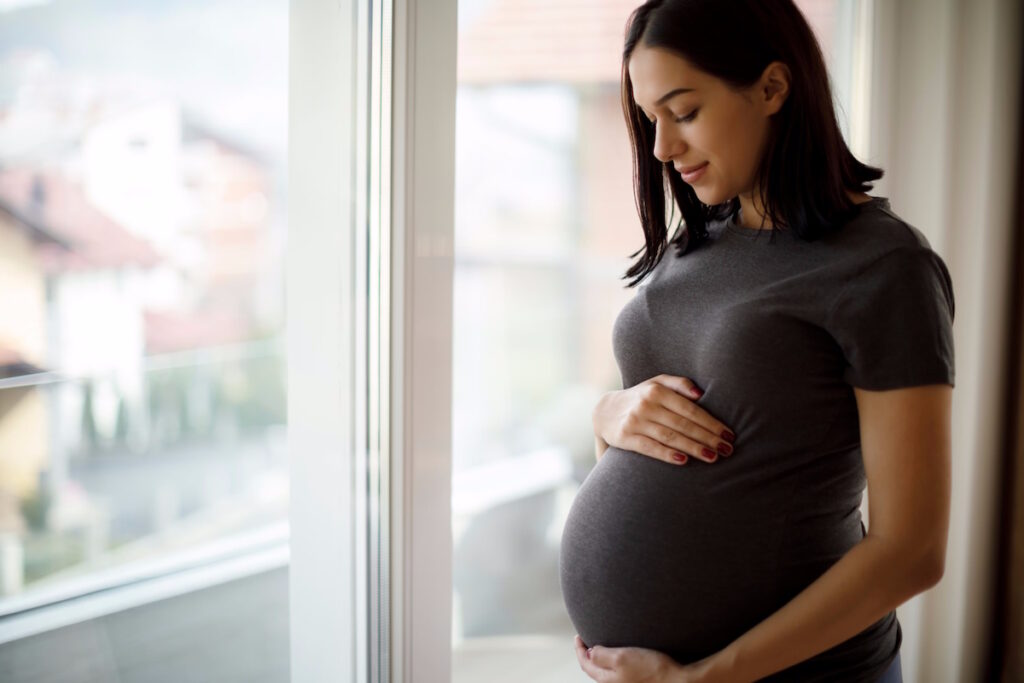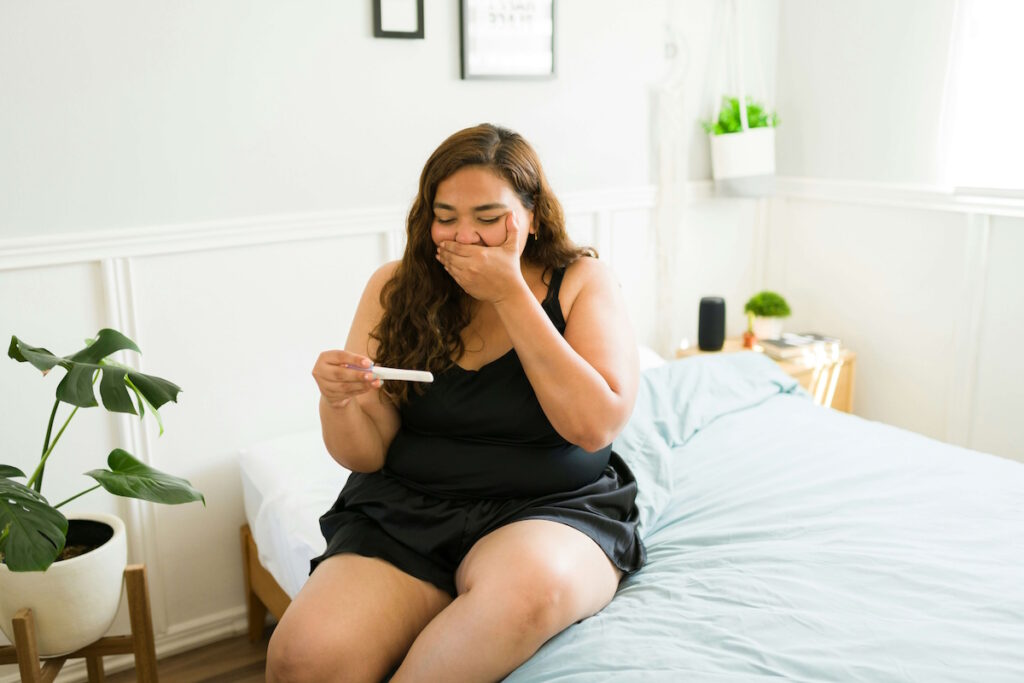We often encounter women who ask if they can still get pregnant despite a uterine fibroid diagnosis. They also wonder what might happen to their fertility if they choose Uterine Fibroid Embolization (UFE) as a treatment option. These are valid questions. After all, while fibroids are typically diagnosed in women between the ages of 35 and 54, younger women are certainly not in the clear. This can be a scary realization, especially if you have dreams of starting or continuing to grow your family. Fibroids can make it difficult to get pregnant and may increase your chances of a difficult pregnancy or miscarriage. And if that were not enough, then there is the question of which treatment option to choose.
While Uterine Fibroid Embolization (UFE) has helped many women find relief from fibroid symptoms, concerns about its own impact on fertility are valid and worth discussing. With June being Infertility Awareness Month, all women—especially those who do not know they have fibroids until they are trying to conceive—need to be as informed as possible on this important topic.
Can Fibroids Increase Your Chances of Infertility?
It bears repeating that fibroids can make it difficult for you to get pregnant as well as increase your chances of experiencing a challenging pregnancy—up to and including miscarriage. But it is important to note first that many women with fibroids have no problems getting pregnant. In fact, many of those same women go on to have a healthy pregnancy and baby. Why is this the case? Simply put, the odds are more in your favor than you think. Infertility affects just under 2% of women between the ages of 20 and 44—regardless of whether fibroids are in the picture or not. Furthermore, the American Society for Reproductive Medicine states that fibroids are only found in 2% to 12% of pregnant women. Most fibroids do not become large enough to cause problems like the ones mentioned above. If a fibroid grows, it usually does so in the first 12 weeks of pregnancy.
So, yes, many patients with fibroids can get pregnant.

That said, if you have fibroids and are having trouble getting pregnant, there might be a correlation. In fact, studies consistently show that fibroids are one of the most common causes of infertility and complications in pregnancy. Here’s why: Fibroids develop in and around the uterus, which, as you know, is where your baby grows. Depending on your situation, you may have one or several fibroids—each differing in size and growing at different rates.
It is that size, location, and growth rate that can affect pregnancy in numerous ways. For instance, fibroids that bulge into the center of the uterus can make it more difficult for an embryo to implant into the lining of the uterus. It is generally acknowledged that the closer the fibroid is to the uterine cavity and the endometrium lining, the more unfavorable effect it might have on fertility, reducing the odds of successful implantation and gestation.
Infertility affects just under 2% of women between the ages of 20 and 44—regardless of whether fibroids are in the picture or not.
Additional examples of how fibroids impact fertility include but aren’t limited to the following:
- Creating changes in the cervix’s shape
- Reducing the number of sperm that can enter the uterus
- Stopping a fertilized egg from implanting properly in the uterus
- Dangerously affecting the baby’s positioning
- Limiting blood flow to the placenta, causing miscarriage
- Abnormal blockage of the fallopian tubes
- Premature birth
- Abnormal blood loss during delivery
- Increasing the chances of a cesarean section
Beyond conception, fibroid symptoms themselves can impact everyday life in blatant and subtle ways, including your most intimate relationship and your self-esteem. These symptoms can include everything from heavy menstrual bleeding and cramping to pelvic pain and pressure, urinary frequency, and pain during intercourse.
The American Society for Reproductive Medicine states that fibroids are only found in 2% to 12% of pregnant women.
Studies Shows Uterine Fibroid Embolization (UFE) May Restore Fertility
Longtime go-to fibroid treatment procedures like a hysterectomy are surgically invasive and not the right option for women seeking future pregnancies. A hysterectomy removes all or part of a woman’s uterus and, in some cases, the fallopian tubes and ovaries. Other procedures like endometrial ablation remove the inside lining of the uterus to reduce heavy bleeding and are also not the right approach.
That leaves two options for women who wish to increase their fertility and have a healthy pregnancy in the future.
Myomectomy
Unlike a hysterectomy, a myomectomy removes fibroids from the uterus while leaving the uterus in place. This can sometimes be performed through the vagina, but it usually involves surgical incisions in the abdomen or pelvis. The number, size, and positions of the fibroids determine whether they can be removed laparoscopically through several small incisions or whether a larger incision is required. Approximately 30,000 myomectomy surgeries are performed annually. Many patients say they no longer experience fibroid pain and symptoms. The typical recovery time is 2-6 weeks. However, it eliminates the ability to have a vaginal birth in the future. Yes, you can still get pregnant, but most gynecologists insist on a C-section after a myomectomy.
Uterine Fibroid Embolization (UFE)
Sometimes, a woman is not considered a good candidate for surgery. Or, she is unwilling to have surgery for various reasons, including because she hopes to have children in the future. This is where UFE comes into play, as it is commonly used to treat symptoms of fibroids without surgery. A tiny tube is fed through the blood vessels right to the fibroids. Their blood supply is blocked from the inside, causing them to shrink and die. The UFE procedure is commonly used to treat the symptoms of fibroids without surgery, and it is over 90% effective. The best part is that women can go home the same day, and the recovery time is only about one week.

Research About Uterine Fibroid Embolization (UFE) and Infertility
This is where the conversation about UFE gets a little nuanced. UFE was not recommended in the past for women who are trying to get pregnant because prior studies showed it can increase the risks during pregnancy. There is an increased risk of miscarriage, pre-term delivery, having the fetus lined up in ways other than head down in the uterus, and abnormalities of the placenta in women who have had UFE. However, this is misleading because all those complications occur in women if they have untreated fibroids. They also occur more commonly with age. In fact, their frequency may not be any different than that seen in similarly aged women with fibroids who are not treated with UFE.
A review of multiple medical articles about fertility after UFE found that the overall pregnancy rate for women who had UFE was 58.6%. The miscarriage rate is 28%. Both numbers are similar to women with fibroids who do not have UFE. There has been one small study that compared pregnancy after UFE in 26 women to pregnancy after myomectomy in 40 women. The pregnancy rates were 50% for those who had UFE and 78% for those who had myomectomy. The miscarriage rate was 53% for those who had UFE and 19% for those who had myomectomy. For this reason, myomectomy has been considered the treatment of choice for women with infertility and fibroids.
However, in June 2017 an article was published that may change views towards UFE for women who want to get pregnant. In a study that included 359 infertile women who chose UFE for the treatment of their fibroids, 149 women became pregnant. The overall pregnancy rates were 30% in the first year after the procedure and 40% within 2 years of UFE. For more than 86% of the women, this was their first pregnancy. They had never been able to get pregnant before, even though some of them had undergone myomectomy in the past and some of them had tried in vitro fertilization. Of the women who became pregnant, 72% had a baby. The overall rates of live births were 24% in the first year after the procedure and 37% within 2 years of UFE. It is also important to note that the rates of pregnancy complications were comparable to all women.
For women who are not candidates for myomectomy and for women who do not want to undergo surgery, it is encouraging that this more recent study has confirmed that there is hope of becoming pregnant—even for those who have not been able to in the past. For women whose infertility is due to fibroids, treating the fibroids with UFE significantly increases their chances of getting pregnant and having a baby.

There was another study done more recently with women who were trying to get pregnant for two years unsuccessfully. There was no reason for their infertility other than fibroids. In those cases, the women either were not a candidate for myomectomy (too many fibroids or it was not safe to take them out), or they refused surgery. They were instead offered UFE. In that group, 40% got pregnant and 36% had a healthy baby. Therefore, this shows growing evidence to support a lower miscarriage rate for UFE than previously believed.
With more research, we may see miscarriage rates between UFE and myomectomy balance out in the future.
For women whose infertility is due to fibroids, treating the fibroids with UFE significantly increases their chances of getting pregnant and having a baby.
A Uniquely Supportive UFE Experience at Fibroid Institute
Fibroids and infertility are huge topics of conversation for women with fibroids who want to have a baby in the future. Growing evidence suggests that you can undergo a successful UFE procedure and still get pregnant. At Fibroid Institute Texas, we do have cases of women successfully getting pregnant and having a healthy baby after Uterine Fibroid Embolization. This is all assuming that you and your doctor work together and that you find a team of fibroid specialists who use the right approach. When the time is right, and the correct treatment option presents itself, your doctor and our team of UFE experts are ready to take that next step with you.
At Fibroid Institute, we do not believe you need to decide between suffering in silence and having invasive surgery. That is why our fibroid doctors offer Uterine Fibroid Embolization, the gold standard in non-surgical fibroid treatment. In addition, we simplify your UFE journey, managing everything from concierge-level care to insurance coordination and PCP communication, unique recovery protocols, and physician-direct access before and after your procedure. Our team goes far beyond the standard procedure techniques, offering our patients a uniquely supportive experience so they can return to the life they love with confidence. With multiple locations, our Dallas and Houston fibroids doctors help thousands of women avoid fibroid surgery and find relief from their fibroid symptoms.
Request a free 10-15-minute phone screening to determine if you are eligible. If you qualify for UFE after the screening, you can schedule your on-site or telehealth consultation. Most major medical insurance providers cover the cost of UFE. We are dedicated to helping you become #FibroidFree. Get started now in Dallas at 214-838-6440, in Houston at 713-903-3733 or complete the form below.
This information is not a substitute for professional medical advice. Before starting any new treatment or if you have questions regarding a medical condition, always seek the advice of your doctor or other qualified health provider.
Fibroid Institute Texas serves the Dallas and Houston areas including Houston, Sugar Land, Katy, Webster, Clear Lake, The Woodlands, Universal City, Spring, Kingwood, Stafford, Conroe, Texas City, Cypress, League City, Bellaire, Addison, Carrollton, Plano, Frisco, Craig Ranch, McKinney, Allen, Fort Worth, Grand Prairie, Hurst, Euless, Bedford, Arlington, Hutchins, Irving, Duncanville, DeSoto, Cedar Hill, Lancaster, Cockrell Hill, Highland Park, University Park, Park Cities, Garland, Mesquite, Richardson, Dallas, Sherman, and more.
*Patient names and/or photos may be changed to protect patient confidentiality.

